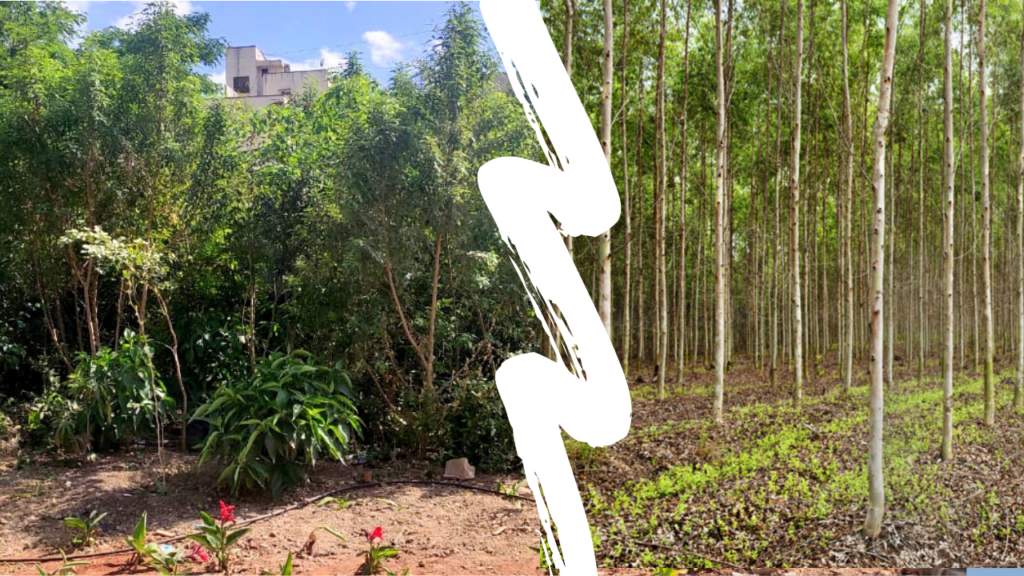

We cut forests and tend to compensate it with plantations! The question is does simple plantations, function in the same way as forests does?
Sometime in between humans started seeing trees as individuals and not ecosystems. Somewhere we started weighing trees more for aesthetics and less for their value for storing water, holding soil, cleaning air, storing carbon, harbouring wildlife etc. Each of these ecological services are free, cannot be measured grossly in economic terms and cannot be provided by any other entity than forests.
We started making lawns, creating plantations and started treating trees as individuals in isolated terms. Plantations tend to plant trees five to six feet apart. It also emphasizes on fast growing, exotic or hybrid trees with limited species diversity. We called it “Landscaping”.
The landscaped area perceived as beautiful where fallen leaves are removed, trees are trained to grow in certain ways and vast laws are spread. Every sort of attempt is being made in gardens to protect trees from grasses, herbaceous plants, lianas, lichens, fungus and insects. We failed to understand that these are very components which create forests.
Well landscaped areas can be part of urban sprawl, but we must understand that they do not provide ecological services at forests does.
As humans, we tend to live in a community-in family, in society. It gives us psychological strength and sense of security. Similarly, plants in their community, as forests, are stronger and protected from adverse environmental conditions. In plantations and in isolation plants are weak and vulnerable.
Without this understanding people prefer to do plantation as they perceive it easy to do and cheap. But if we do cost benefit analysis of forestry vs plantation, plantation stands on very shaky ground.
As per India State of Forest Report 2019 green cover of India is increasing. If we stick to definition, then any fruit garden, mango or coconut plantation, and urban parks would come under ‘forest cover’. We get a misleading picture of our forests, while forests are being cut, destroyed, fragmented mercilessly with very fast pace.
Even with destruction of one rich forest, thousands of old growth trees, rare and endemic plants, lianas, orchids, natural springs, natural water holes, lichens, mosses, mulch, humus and innumerable known and unknown insects, bees, birds, reptiles and mammals vanish for ever. With each tract of lost forests, we are losing water holding capacity of soil and with it getting ever depleting water aquifers.
So, where it leads us to? One solution is to conserve the remaining forests. Another can be to regenerate forests.
Conservation of remaining forests can be through-
Regeneration of forests is the area where each of us can play role.
Regeneration of forests can be achieved by restoration of degraded lands through forestry techniques. There are few forestry techniques like Miyawaki technique which have been proved successful in land restoration in various terrains and different geographical locations. However due to cost involved in the forestry it is being done in limited capacity. Again, the cost benefit analysis can prove that forestry has multifold benefits which forests starts generating in 5-7 years. Regenerated forests do provide most goods and services that are provided by natural forests.
Food forests, forests planted with commercial aspects are such kinds of forests which become viable as medicines, herbs, fruits, flowers, gum, timber can be harvested while they recharge ground water, increase soil nutrients, increase water holding capacity of soil, clean the air, regulate microclimate, store carbon and enrich the larger ecosystem through biodiversity conservation.
To carry out habitat restoration, any forestry technique or dense plantation technique based on basic principles of forestry, can be employed. Such local techniques can be researched and derived considering geography, local soil conditions, original vegetation, original forest areas, ground requirements, locally available material etc. Designing such local forestry techniques based on basics of forestry and with the help of available forestry techniques can be cost effective and key to large scale habitat restorations.
We as individuals, as part of our neighbourhood, as employees or as leaders should understand this first and spread the message that we need to bring forests back. Be it in climate change perspective or minimizing pollution or recharging groundwater, we need to prioritize forests over plantations. Each of our landscaped area can have one part of forest trees.We need to do forestry on a large scale. And all of us must contribute to it. Let’s conserve forests and then from there forests will take care.

She conceptualized FORREST to conserve, to Inspire and to connect people back to nature. Her interest lies in Habitat ecology. A poet by nature with a touch of the wild.


We plan to restore a forest of 20000 trees in the monsoon of July 2021! And we need your help to do that! Contribute saplings in Vruksh Khosh or donate Rs. 50 per sapling.